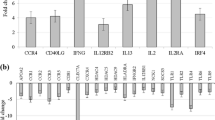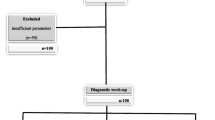Abstract
Vitamin D is important for calcium homeostasis, muscle, and bone health. It has also immunomodulatory capacities in vivo and in vitro. Regulatory T cells (Treg) have been found to suppress a number of T cell-mediated immune disorders, including allergic responses and autoimmune diseases. This study aimed to investigate the correlation between 25-hydroxyvitamin D (25(OH)D) levels and the regulatory T cells in cord blood. The study group is comprised of 101 full-term newborn infants. Umbilical cord 25(OH)D levels and number and percentage of T lymphocyte, T helper, and Treg cells were measured. Infants were grouped according to 25-hydroxyvitamin D levels (25(OH)D <12 ng/ml and 25(OH)D >12 ng/ml) (converting factor of 25OHD level into SI unit, 2.6). Severe vitamin D deficiency (25(OH)D <12 ng/ml) was observed in 32% of the infants. There was no significant correlation between 25-hydroxyvitamin D levels and T cell number and percentages. There were also no significant differences in white blood cell, total lymphocyte count, T helper, and Treg cell percentage and number between groups. These results suggest that the serum level of 25-hydroxyvitamin D is not crucially involved in the correlation between vitamin D status and T cell regulation in cord blood.

Similar content being viewed by others
References
Borrego LM, Arroz MJ, Videira P, Martins C, Guimaraes H, Nunes G, Papoila AL, Trindade H (2009) Regulatory cells, cytokine pattern and clinical risk factors for asthma in infants and young children with recurrent wheeze. Clin Exp Allergy 39:1160–1169
Bouillon R, Carmeliet G, Daci E, Segaert S, Verstuyf A (1998) Vitamin D metabolism and action. Osteoporos Int 8:S13–S19
Bowyer L, Catling-Paull C, Diamond T, Homer C, Davis G, Craig ME (2009) Vitamin D, PTH and calcium levels in pregnant women and their neonates. Clin Endocrinol (Oxf) 70:372–377
Bystry RS, Aluvihare V, Welch KA, Kallikourdis M, Betz AG (2001) B cells and professional APCs recruit regulatory T cells via CCL4. Nat Immunol 2:1126–1132
Cakmak FN, Erol M, Ergül P, Yalcyner A (1997) T lymphocytes and vitamins. J Pediatr 130:77–85
Cohen JL, Trenado A, Vasey D, Klatzmann D, Salomon BL (2002) CD4(+)CD25(+) immunoregulatory T cells: new therapeutics for graft-versus-host disease. J Exp Med 196:401–406
DeLuca HF, Cantorna MT (2001) Vitamin D: its role and uses in immunology. FASEB J 15:2579–2585
DeLucia M, Carpenter T (2000) Rickets in the sunshine? Nutrition 8:97–98
Ellman P, Anderson KH (1948) Calciferol in tuberculous peritonitis with disseminated tuberculosis. BMJ 1:394
Furtado GC, Olivares-Villagomez D, Curotto de Lafaille MA, Wensky AK, Latkowski JA, Lafaille JJ (2001) Regulatory T cells in spontaneous autoimmune encephalomyelitis. Immunol Rev 182:122–134
Garland CF, Garland FC, Gorham ED (1991) Can colon cancer incidence and death rates be reduced with calcium and vitamin D? Am J Clin Nutr 54:193S–201S
Gregori S, Casorati M, Amuchastegui S, Smiroldo S, Davalli MA, Adorini L (2001) Regulatory T cells induced by 1α,25-dihydroxyvitamin D3 and mycophenolate mofetil treatment mediate transplantation tolerance. J Immunol 167:1945–1953
Griffin MD, Lutz W, Phan WA, Bachman LA, McKean DJ, Kumar R (2001) Dendritic cell modulation by 1α,25 dihydroxyvitamin D3 and its analogs: a vitamin D receptor-dependent pathway that promotes a persistent state of immaturity in vitro and in vivo. Proc Natl Acad Sci U S A 98:6800–6805
Gysemans C, van Etten E, Overbergh L, Giulietti A, Eelen A, Waer M, VerstuyfA BR, Mathieu C (2008) Unaltered diabetes presentation in NOD mice lacking the vitamin D receptor. Diabetes 57:269–275
Hamzaoui K, Ben Dhifallah I, Karray E, Sassi FH, Hamzaoui A (2010) Vitamin D modulates peripheral immunity in patients with Behçet’s disease. Clin Exp Rheumatol 28(4 Supppl 60):s50–s57
Holick MF (2004) Sunlight and vitamin D for bone health and prevention of autoimmune diseases, cancers, and cardiovascular disease. Am J Clin Nutr 80(8 Suppl):1678s–1679s
Karlsson MR, Rugtveit J, Brand Zaeg P (2004) Allergen responsive CD4+CD25+ regulatory T cells in children who have outgrown cow’s milk allergy. J Exp Med 199:1679–1688
Lapatsanis D, Moulas A, Cholevas V, Soukakos P, Papadopoulou ZL, Challa A (2005) Vitamin D: a necessity for children and adolescents in Greece. Calcif Tissue Int 77:348–355
Maloy KJ, Powrie F (2001) Regulatory T cells in the control of immune pathology. Nat Immunol 2:816–822
Manolagas SC, Hustmyer FG, Yu XP (1990) Immunomodulating properties of 1,25-dihydroxyvitamin D3. Kidney Int 38:S9–S16
Mathieu C, Adorini L (2002) The coming of age 1,25-dihydroxyvitamin D3 analogs as immunomodulator agents. Trends Mol Med 8:174–179
Mathieu C, Waer M, Casteels K, Laureys J, Bouillon R (1995) Prevention of type 1 diabetes in NOD mice by non hypercalcemic doses of an new structural analog of 1,25-dihydroxyvitamin D3, KH1060. Endocrinology 3:866–872
Najada AS, Habashneh MS, Khader M (2004) The frequency of nutritional rickets among hospitalized infants and its relation to respiratory diseases. J Trop Pediatr 50:364–368
Nemere I, Farach-Carson MC (1998) Membrane receptors for steroid hormones: a case for specific cell surface binding sites for vitamin D metabolites and estrogens. Biochem Biophys Res Commun 248:442–449
Ng WF, Duggan PJ, Ponchel F, Matarese G, Lombardi G, Edwards AD, Isaacs JD, Lechler RI (2001) Human CD4+CD25+ cells: a naturally occuring population of regulatory T cells. Blood 98:2736–2744
Norman AW (1998) Receptors for 1α-25(OH)2D3: past, present and future. J Bone Res 13:1360–1369
Pozzilli P, Manfrini S, Crino A, Picardi A, Leomanni C, Cherubini V (2005) Vitamin D3 and type 1 diabetes. Horm Metab Res 37:680–683
Prietl B, Pilz S, Wolf M, Tomaschitz A, Obermayer-Pietsch B, Graninger W, Pieber TR (2010) Vitamin D supplementation and regulatory T cells in apparently healthy subjects: vitamin D treatment for autoimmune diseases? Isr Med Assoc J 12:136–139
Read S, Malmstrom V, Powrie F (2000) Cytotoxic T lymphocyte-associated antigen 4 plays an essential role in the function of CD25(+)CD4(+) regulatory cells that control intestinal inflammation. J Exp Med 192:295–302
Sachan A, Gupta R, Das V, Agarwal A, Awasthi PK, Bhatia V (2005) High prevalence of vitamin D deficiency among pregnant women and their newborns in northern India. Am J Clin Nutr 81:1060–1064
Sakaguchi S, Sakaguchi N, Asano M, Itoh M, Toda M (1995) Immunologic self-tolerance maintained by activated T cells expressing IL-2 receptor α-chains (CD25). Breakdown of a single mechanism of self-tolerance causes various autoimmune diseases. J Immunol 155:1151–1164
Sakaguchi S, Sakaguchi N, Shimizu J, Yamazaki S, Sakihama T, Itoh M, Kuniyasu Y, Nomura T, Toda M, Takahashi T (2001) Immunologic tolerance maintained by CD25+CD4+ regulatory T cells: their common role in controlling autoimmunity, tumor immunity, and transplantation tolerance. Immunol Rev 182:18–32
Takahashi T, Tagami T, Yamazaki S, Uede T, Shimizu J, Sakaguchi N, Mak TW, Sakaguchi S (2000) Immunologic self-tolerance maintained by CD25(+)CD4(+) regulatory T cells constitutively expressing cytotoxic T lymphocyte-associated antigen 4. J Exp Med 192:303–310
Takeuchi A, Reddy GS, Kobayashi T, Okano T, Park J, Sharma S (1998) Nuclear factor of activated T cells (NFAT) as a molecular target for 1α,25-dihydroxyvitamin D3-mediated effects. J Immunol 160:209–218
Tang J, Li BQ, Ruan J, Zhang LJ (2008) Expression of Foxp3 in CD4CD25(high) Treg cells of neonatal cord blood. Xi Bao Yu Fen Zi Mian Yi Xue Za Zhi 24:365–367
Thornton AM, Shevach EM (2000) Suppressor effector function of CD4+CD25+ immunoregulatory T cells is antigen nonspecific. J Immunol 164:183–190
Acknowledgments
We thank Dr. Berkan Gürakan for the helpful comments for this study. We also thank Ömer Keleş, Ayşegül Haberal, and Ilknur Kozanoğlu for the technical support and for providing us the laboratory data during the study period.
Conflicts of interest
Authors declare no financial interests with the organization that sponsored the research.
Author information
Authors and Affiliations
Corresponding author
Rights and permissions
About this article
Cite this article
Güven, A., Ecevit, A., Sözer, O. et al. Correlation between the cord vitamin D levels and regulatory T cells in newborn infants. Eur J Pediatr 171, 1161–1166 (2012). https://doi.org/10.1007/s00431-012-1688-6
Received:
Accepted:
Published:
Issue Date:
DOI: https://doi.org/10.1007/s00431-012-1688-6




